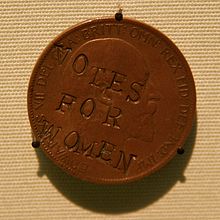User:MsJoat/Suffragette penny
Suffragette Penny
[edit]

The Suffragette penny is the name given to surviving examples of pre-decimal British pennies that were defaced by British suffragettes. They were a more subtle, but no less direct, form of protest than window breaking and arson. There are currently only 10 or 11 pennies known to exist and all are believed to date from 1913.[1][2]
Each penny was hand stamped using metal punches and a hammer. Of the existing examples, all have the words across the head of the king, either Edward VII or George V. The exception to this is the three coins minted during the reign of Queen Victoria's, where the words are on the tail.[3][4] The surviving coins can be identified by the similarities in the 'T', 'M', 'E' and 'O'.[4]
Press reports of the time suggest that the suffragettes were taking inspiration from anarchists who were known to stamp coins with the words "Vive L'Anarchie" on coins.[4]
In 2010, the coin held by the British Museum was featured as part of A History of the World in 100 Objects, a joint project between the museum and BBC Radio 4.[2] However, Hockenhull notes that while its inclusion brought a greater awareness to the coins, it also created a market for counterfeits and imitations. According to him, there are only 10 coins that can be considered true suffragette pennies.[4] Although all the coins are referred to as pennies, one of the surviving coins is actually a half crown.[4]

- ^ "Look, think, do: "Votes For Women" Coin". The Fitzwilliam Museum. Retrieved 23 April 2022.
- ^ a b "BBC Radio 4 - A History of the World in 100 Objects, Mass Production, Mass Persuasion (1780 - 1914 AD), Suffragette-defaced penny". BBC. Retrieved 23 April 2022.
- ^ Defacing money: The Suffragette Penny | Curator's Corner S2 Ep 4 #CuratorsCorner, retrieved 23 April 2022
- ^ a b c d e Hockenhull, Tom (2016). "Stamped all over the King's Head: Defaced Coins and Women's Suffrage" (PDF). British Numismatic Journal. 86: 238–245.
